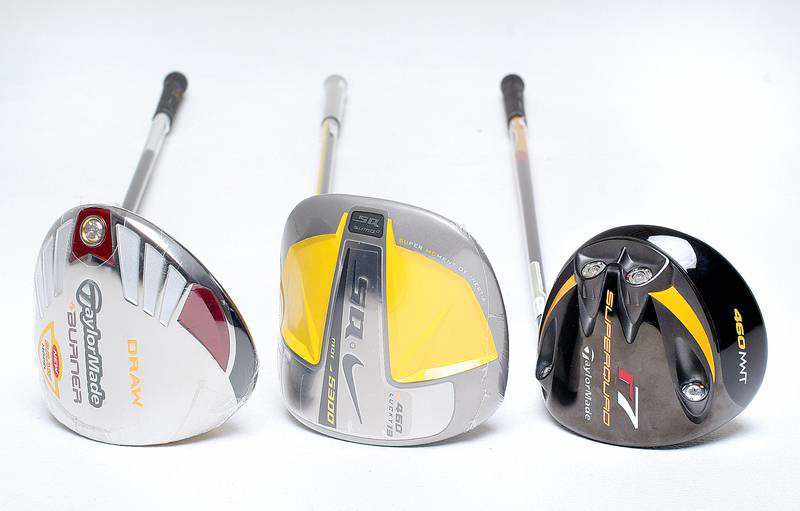Drive for show
Published 4:00 am Wednesday, December 5, 2007

- At left, the TaylorMade Burner Draw sells for $299.95 at Pro Golf of Bend. Center, the Nike SQ 5300 Lucky 13 ($399.99 at Pro Golf of Bend) is a square-headed driver, a design that is revolutionizing the market. At right, the TaylorMade r7 Superquad 460 MWT ($399.95 at Pro Golf of Bend) is adjustable with a series of screws at the bottom of the club.
No single golf club has changed more during the last decade or so than the driver.
The changes in technology for drivers have been swift to come and have overwhelmed the market, making the driver the centerpiece of most golfers’ new equipment.
Equipment manufacturers have been in an arms race since Callaway revolutionized drivers with the Big Bertha oversized driver in the early 1990s.
Drivers now hardly resemble the earliest versions of metal woods — which were typically 140 cubic centimeters in volume — much less their wooden predecessors.
The sizes of driver club heads have more than doubled from the original Big Bertha of 195 cubic centimeters — which seemed massive at the time — to the current United States Golf Association regulation limit of 460 cubic centimeters.
The shapes are also changing, including the hottest new trend: square-headed drivers.
But with the changes, shopping for a driver has become infinitely more complicated than before oversized drivers became popular. If the purchase is intended as a Christmas gift for somebody else, it can be nearly impossible.
“Unless (Christmas shoppers) know specifically what they want, and (the gift recipient) asks for it — ‘Hey Dad, I want a Callaway, Titleist Z-58, x shaft,’ which for the most part they don’t have that knowledge or haven’t been able to try that club — buying a driver can be difficult,” says Bruce Wattenburger, head pro at Juniper Golf Club in Redmond. “I would encourage them to buy some kind of gift certificate.”
Christmas
Winter is typically the best time to buy a driver because many retail outlets have put their 2007 models on sale to clear the deck for the 2008 versions.
And it appears drivers likely won’t reach obsolescence as quickly as in years past, providing better value.
Changing technology may be slowing, because the USGA’s limits on club-head size means manufacturers are at the end of their ropes as far as building bigger drivers.
“They would have kept going if (the USGA) wouldn’t have stopped it,” says Lee Roberts, head pro at Meadow Lakes Golf Club in Prineville.
Though difficult to shop for, drivers still make a good gift, especially for a golfer who has been playing with a driver that is five years old or older.
The simple fact is that most golfers want to hit the ball farther, and the newest drivers will help them do that.
“They have gotten better,” says Mike Palen, director of golf instruction for Sunriver Resort. “(Manufacturers) are using higher-quality metals. All the research they’ve done (has helped with) how they can make them more forgiving, and how they can make the club faces sometimes thinner so they get more of a trampoline effect. Moving weight around (in the club head) has done a little for a person that mis-hits it. (New drivers) definitely make a difference.”
Drivers often look as if they were created by a science-fiction writer, but these modern clubs are genuinely easier to hit and allow a golfer to hit the ball farther than ever before.
Perhaps the most innovative drivers on the market today are the Nike SasQuatch Sumo Squared Driver (which costs around $400, and the Callaway FT-i (which costs $500 or less, depending on the outlet).
Both drivers’ square heads supposedly help a golfer hit the ball farther and more accurately than a traditional design.
Other big players in the driver market, such as Adams Golf, will be unveiling their own squared drivers in the coming years.
The more conventionally shaped and top-selling TaylorMade r7 Superquad ($399.95, Pro Golf of Bend), allow golfers to adjust the weighting in the club head with a wrench to compensate for such results as fades or slices.
But selecting a driver comes down to three factors: look of the club, flex in the shaft, and loft of the club.
“When you are dealing with the top-flight companies, they are all right there on quality whether it is a Ping, Titleist or Callaway,” says Roberts. “But the golfer has to look down and like the way that club looks.”
Time to buy
Drivers are not a small investment. A new good-quality driver will likely cost at least $200, and many cost more than $500.
But which one is best is a matter of personal preference, and finding the right one is crucial to achieve lower scores.
“They are going to be buying a club that they in all probability are going to be using as a percentage very high in the number of shots during the round,” says Wattenburger, who estimated that the average golfer uses his or her driver at least 14 times during the round. “Having a driver you can hit is obviously very important.”
A golfer’s swing, with all its deficiencies, matters more than the price or brand of a driver.
For example, each of Cobra’s line of drivers has offset versions for golfers who tend to hit a fade or slice.
Other drivers are weighted heavier in the heel to compensate for slices.
And the loft of each driver varies, typically ranging from 8 to 13 degrees. Which loft is best depends on swing speed — the slower the swing of the golfer, the higher degree of loft is needed.
But how can golfers know what is best for them?
Palen, Roberts and Wattenburger all agree that it comes down to trying the clubs before you buy.
Manufacturers host demo days at golf courses throughout Central Oregon during the warmer months, allowing golfers to try out their clubs.
Also, most local golf retailers offer free club-fitting services.
Wattenburger says that, for instance, every club in the Juniper pro shop is available for demo, and Roberts says he will go to the driving range with a prospective buyer to help the golfer make the best buy.
“There is no stipulation to buy,” Roberts says. “Let’s just see what fits you best, and you can go find the best price, that’s fine with me. If it happens to be us, that’s great.”
More to come
This is the third story in a five-week series on shopping for golfers this Christmas season.






